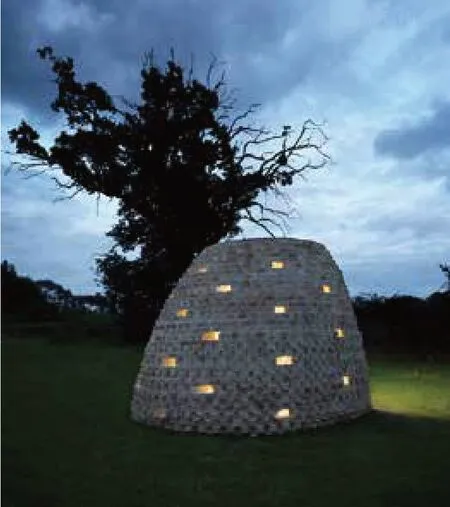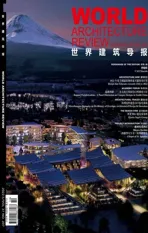数字设计砖房
2022-11-16NAARO,GuanLee

建筑设计:Piercy&Company 与建筑材料实验室(MAL)| 地点:英国 | 摄影:NAARO,Guan Lee
Design Company: Piercy&Company and Material Architecture Lab (MAL) | Location: United Kingdom | Photo credits: NAARO,Guan Lee








伦敦大学巴特莱特建筑学院建筑材料实验室(MAL)与位于伦敦的Piercy&Company 建筑工作室正在携手合作展开研究。其第一个项目是实验性的数字设计砖房——Code-Bothy。该合作项目称为“创造与实践”,它融合了数字制造技术与材料实验方面的专业知识。
该项目通过将研究主题以全尺寸结构实现,旨在发掘工艺、设计与建筑领域方面的新应用,并为业界提供概念证明。这一合作为两名刚从巴特莱特建筑学院毕业的学生提供了为期两个月的工作机会,岗位分别在建筑材料实验室和Piercy&Company 建筑工作室。
传统小屋(荒僻地区的基本住所)呈现出原初的几何构型,但是,Code-Bothy 利用参数建模,生成了具有复杂错缝砖砌结构的曲线构型。它建在白金汉郡的Grymsdyke 农场上,砖瓦工人佩戴着显示3D 模型信息的增强现实(AR)头戴设备。砖瓦工人的操作常常有悖于直觉,成功建起了这种有意复杂的构型。研究的相关性的关键在于数字/人工的联系:在现场使用增强功能(AR)头戴设备,可在实践中实现复杂的参数与数字设计;这种设计已进行了模型结构测试,但在砖瓦工人看来似乎不合情理。利用参数化建模减少材料浪费、尽量减少材料的超量使用、并让结构尽可能精简高效,借此,学术及实践方面正在取得进步。Code-Bothy 表明了此类进步是如何利用建筑人力的已有技能,在实际施工环境中相对便捷地应用的。
在美观、形式趣味和纹理之乐的驱动下,Code-Bothy的灵感来自于对可持续砖砌建筑的新的表达方式的追求。Code-Bothy 砖砌的角度逐渐旋转,形成复杂而美观的图案,激发了朴素砖墙的美学新价值。人们在可持续建筑中能获得快乐和愉悦。Code-Bothy 展示了一个(积极乐观的)愿景:即参数化与增强现实(AR)的数字工具可提升砖瓦工人的技能、细微判断以及把握时机的能力。正是数字与人工的结合,使得构型的可能性、材料使用减少、以及砖砌建筑的可视化表达都得到扩展。
Code-Bothy is an experimental digitally-designed brick shelter and the first project borne from an ongoing research partnership between Material Architecture Lab (MAL) at The t and London-based architecture studio,Piercy&Company.Called ‘Making and Practice’,the partnership brings together expertise in digital fabrication techniques and material experimentation.
It aims to find new applications in craft,design and architecture and provide proof of concept to industry by realising research subjects as full-size structures.The partnership provides two-month placements to two recent graduate students from The Bartlett,divided between MAL and Piercy&Company.Whereas rudimentary geometries form a traditional bothy (a basic shelter in remote areas),Code-Bothy uses parametric modelling to generate a curved form with a complex offset brick structure.Built on-site at Grymsdyke Farm in Buckinghamshire,the bricklayer wore an AR (augmented reality) headset displaying information from the 3D model.The bricklayer,often working against intuition,successfully constructed the intentionally complex form.The digital/manual connection lies at the heart of the research’s relevance: the use of the AR headset on-site enabled the practical realisation of the complex parametric and digital design,a design that had been structurally tested in the model but seemed implausible to the bricklayer.Advances are being made across academia and practice using parametric modelling to reduce wasted materials,minimise material overuse,and push structures to be as efficient and lean as possible.Code-Bothy demonstrates how these advances can be relatively simply applied in a real construction environment using the existing skills of the construction labour force.
Code-Bothy was motivated by the search for a new language for sustainable brick architecture -driven by beauty,formal playfulness and textural delight.The gradually rotating angles of the brickwork for Code-Bothy create a complex and beautiful pattern,prompting an aesthetic reassessment of the humble brick.There is joy and delight to be found in sustainable architecture.Code-Bothy proposes an (optimistic) vision: one where the bricklayer’s skills,fine judgement,and timing are enhanced by the digital tools of parametrics and AR.It is the combination of the digital and manual that the structural possibilities,material use reduction and visual language of brick architecture are expanded.

